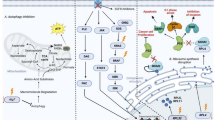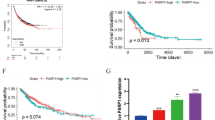Abstract
Small-cell lung cancer (SCLC) is a highly malignant carcinoma with poor long-term survival. Effective treatment remains highly demanded. In the present study, we demonstrated that External Qi of Yan Xin Qigong (YXQ-EQ) exerted potent cytotoxic effect towards SCLC cell line NCI-H82 via induction of apoptosis. Global gene expression profiling identified 39 genes whose expression was altered by YXQ-EQ in NCI-82 cells. Among them, semi-quantitative RT-PCR and real-time qPCR analyses confirmed that the gene expression levels of apoptotic proteins death-associated protein kinase 2 and cell death-inducing DFFA-like effector b were upregulated, whereas that of oncoproteins DEK and MYCL1, cell migration-promoting proteins CD24 and integrin-alpha 9, and glycolytic enzyme aldolase A were downregulated. These findings suggest that YXQ-EQ may exert anticancer effect through modulating gene expression in a way that facilitates cancer cell apoptosis while represses proliferation, metastasis, and glucose metabolism.






Similar content being viewed by others
Abbreviations
- SCLC:
-
Small-cell lung cancer
- TCM:
-
Traditional Chinese medicine
- YXQ:
-
Yan Xin Qigong
- YXQ-EQ:
-
External Qi of Yan Xin Qigong
- FITC:
-
Fluorescein isothiocyanate
- PI:
-
Propidium iodide
- ITGA9:
-
Integrin alpha 9
- VCAM1:
-
Vascular-cell-adhesion molecule 1
- GRKs:
-
G-protein-coupled receptor kinases
- MYCL1 (or L-Myc):
-
Lung myelocytomatosis viral oncogene homolog 1
- DAPK2:
-
Death-associated protein kinase 2
- CIDE-B:
-
Cell death-inducing DFFA-like effector b
- CAR:
-
Cancer-associated retinopathy
- RCVRN:
-
Recoverin
- ALDOA:
-
Aldolase A
References
Jackman DM, Johnson BE (2005) Small-cell lung cancer. Lancet 366:1385–1396
Thatcher N, Faivre-Finn C, Lorigan P (2005) Management of small-cell lung cancer. Ann Oncol 16(Suppl 2):235–239
Kim YH, Girard L, Giacomini CP, Wang P, Hernandez-Boussard T, Tibshirani R, Minna JD, Pollack JR (2006) Combined microarray analysis of small cell lung cancer reveals altered apoptotic balance and distinct expression signatures of MYC family gene amplification. Oncogene 25:130–138
Yan X, Shen H, Jiang HJ, Zhang CS, Hu D, Wang J, Wu XQ (2006) External Qi of Yan Xin Qigong differentially regulates the Akt and extracellular signal-regulated kinase pathways and is cytotoxic to cancer cells but not to normal cells. Int J Biochem Cell Biology 38:2102–2113
Yan X, Shen H, Jiang HJ, Zhang CS, Hu D, Wang J, Wu XQ (2008) External Qi of Yan Xin Qigong induces G2/M arrest and apoptosis of androgen-independent prostate cancer cells by inhibiting Akt and NF-kappa B pathways. Mol Cell Biochem 310:227–234
Yan X, Shen H, Jiang H, Hu D, Zhang C, Wang J, Wu X (2010) External Qi of Yan Xin Qigong Induces apoptosis and inhibits migration and invasion of estrogen-independent breast cancer cells through suppression of Akt/NF-kB signaling. Cell Physiol Biochem 25:263–270
Lu Z (1997) Scientific Qigong exploration. Amber Leaf Press, Malvern
IYXQA (1997) Yan Xin Qigong collectanea. LOTUS, New York
Ming Z (1988) The new frontiers of modern sciences—an introduction to YanXin Qigong. Xinhua Press, Beijing
Yan X, Fong YT, Wolf D, Shen H, Zaharia M, Wang J, Wolf G, Li F, Lee GD, Cao W (2002) XY99-5038 promotes long-term survival of cultured retinal neurons. Int J Neurosci 112:1209–1227
Yan X, Fong YT, Wolf G, Wolf D, Cao W (2001) Protective effect of XY99-5038 on hydrogen peroxide induced cell death in cultured retinal neurons. Life Sci 69:289–299
Yan X, Lin H, Li HM, Traynor-Kaplan A, Xia ZQ, Lu F, Fang Y, Dao M (1999) Structure and property changes in certain materials influenced by the external qi of qigong. Materials Research Innovations 2:349–359
Yan X, Shen H, Zaharia M, Wang J, Wolf D, Li F, Lee GD, Cao W (2004) Involvement of phosphatidylinositol 3-kinase and insulin-like growth factor-I in YXLST-mediated neuroprotection. Brain Res 1006:198–206
Yan X, Xia ZQ, Shen H, Traynor-Kaplan A (2002) External Qi of Yan Xin life science technology can revive or suppress enzyme activity of phosphatidylinositol 3-kinase. Bull Sci Technol Soc 22:403–406
Xiao L, Lang W (2000) A dominant role for the c-Jun NH2-terminal kinase in oncogenic Ras-induced morphologic transformation of human lung carcinoma cells. Cancer Res 60:400–408
Shinoda C, Maruyama M, Fujishita T, Dohkan J, Oda H, Shinoda K, Yamada T, Miyabayashi K, Hayashi R, Kawagishi Y, Fujita T, Matsui S, Sugiyama E, Muraguchi A, Kobayashi M (2005) Doxorubicin induces expression of multidrug resistance-associated protein 1 in human small cell lung cancer cell lines by the c-jun N-terminal kinase pathway. Int J Cancer 117:21–31
Li C, Tang Y, Li F, Turner S, Li K, Zhou X, Centola M, Yan X, Cao W (2006) 17beta-estradiol (betaE2) protects human retinal Muller cell against oxidative stress in vitro: evaluation of its effects on gene expression by cDNA microarray. Glia 53:392–400
Yu X, Tang Y, Li F, Frank MB, Huang H, Dozmorov I, Zhu Y, Centola M, Cao W (2005) Protection against hydrogen peroxide-induced cell death in cultured human retinal pigment epithelial cells by 17beta-estradiol: a differential gene expression profile. Mech Ageing Dev 126:1135–1145
Dozmorov I, Centola M (2003) An associative analysis of gene expression array data. Bioinformatics 19:204–211
Dozmorov I, Knowlton N, Tang Y, Shields A, Pathipvanich P, Jarvis JN, Centola M (2004) Hypervariable genes—experimental error or hidden dynamics. Nucleic Acids Res 32:e147
Huang H, Frank MB, Dozmorov I, Cao W, Cadwell C, Knowlton N, Centola M, Anderson RE (2005) Identification of mouse retinal genes differentially regulated by dim and bright cyclic light rearing. Exp Eye Res 80:727–739
Chen ZM, Guo K, Toh SY, Zhou ZH, Li P (2000) Mitochondria localization and dimerization are required for CIDE-B to induce apoptosis. J Biol Chem 275:22619–22622
Weber E, Ravi RK, Knudsen ES, Williams JR, Dillehay LE, Nelkin BD, Kalemkerian GP, Feramisco JR, Mabry M (1999) Retinoic acid-mediated growth inhibition of small cell lung cancer cells is associated with reduced myc and increased p27(Kip1) expression. Int J Cancer 80:935–943
Soucek L, Whitfield J, Martins CP, Finch AJ, Murphy DJ, Sodir NM, Karnezis AN, Swigart LB, Nasi S, Evan GI (2008) Modelling Myc inhibition as a cancer therapy. Nature 455:679–683
Zarn JA, Jackson DG, Bell MV, Jones T, Weber E, Sheer D, Waibel R, Stahel RA (1995) The small-cell lung-cancer antigen cluster-4 and the leukocyte antigen Cd24 are allelic isoforms of the same gene (Cd24) on chromosome band 6q21. Cytogenet Cell Genet 70:119–125
Jackson D, Waibel R, Weber E, Bell J, Stahel RA (1992) Cd24, a signal-transducing molecule expressed on human b-cells, is a major surface-antigen on small-cell lung carcinomas. Cancer Res 52:5264–5270
Lydolph MC, Morgan-Fisher M, Hoye AM, Couchman JR, Wewer UM, Yoneda A (2009) Alpha 9 beta 1 integrin in melanoma cells can signal different adhesion states for migration and anchorage. Exp Cell Res 315:3312–3324
Hibi K, Yamakawa K, Ueda R, Horio Y, Murata Y, Tamari M, Uchida K, Takahashi T, Nakamura Y, Takahashi T (1994) Aberrant up-regulation of a novel integrin alpha-subunit gene at 3p21.3 in small-cell lung-cancer. Oncogene 9:611–619
Maeda A, Ohguro H, Maeda T, Wada I, Sato N, Kuroki Y, Nakagawa T (2000) Aberrant expression of photoreceptor-specific calcium-binding protein (recoverin) in cancer cell lines. Cancer Res 60:1914–1920
Bazhin AV, Savchenko MS, Belousov EV, Jaques G, Philippov PP (2004) Stimulation of the aberrant expression of a paraneoplastic antigen, recoverin, in small cell lung cancer cell lines. Lung Cancer 45:299–305
Bazhin AV, Savchenko MS, Shifrina ON, Demoura SA, Chikina SY, Jaques G, Kogan EA, Chuchalin AG, Philippov PP (2004) Recoverin as a paraneoplastic antigen in lung cancer: the occurrence of anti-recoverin autoantibodies in sera and recoverin in tumors. Lung Cancer 44:193–198
Ojika T, Imaizumi M, Abe T, Kato K (1991) Immunochemical and immunohistochemical studies on 3 aldolase isozymes in human lung-cancer. Cancer 67:2153–2158
Lu Y, Jia L, He S, Hurley MC, Leys MJ, Jayasundera T, Heckenlively JR (2009) Melanoma-associated retinopathy a paraneoplastic autoimmune complication. Arch Ophthalmol 127:1572–1580
Kawai T, Nomura F, Hoshino K, Copeland NG, Gilbert DJ, Jenkins NA, Akira S (1999) Death-associated protein kinase 2 is a new calcium/calmodulin-dependent protein kinase that signals apoptosis through its catalytic activity. Oncogene 18:3471–3480
Tur MK, Neef I, Jost E, Galm O, Jager G, Stocker M, Ribbert M, Osieka R, Klinge U, Barth S (2009) Targeted restoration of down-regulated DAPK2 tumor suppressor activity induces apoptosis in Hodgkin lymphoma cells. Journal of Immunotherapy 32:431–441
Wong TS, Chang HW, Tang KC, Wei WI, Kwong DLW, Sham JST, Yuen APW, Kwong YL (2002) High frequency of promoter hypermethylation of the death-associated protein-kinase gene in nasopharyngeal carcinoma and its detection in the peripheral blood of patients. Clin Cancer Res 8:433–437
Zochbauer-Muller S, Fong KM, Virmani AK, Geradts J, Gazdar AF, Minna JD (2001) Aberrant promoter methylation of multiple genes in non-small cell lung cancers. Cancer Res 61:249–255
Erdtmann L, Franck N, Lerat H, Le Seyec J, Gilot D, Cannie I, Gripon P, Hibner U, Guguen-Guillouzo C (2003) The hepatitis C virus NS2 protein is an inhibitor of CIDE-B-induced apoptosis. J Biol Chem 278:18256–18264
Patel JH, Loboda AP, Showe MK, Showe LC, McMahon SB (2004) Opinion—analysis of genomic targets reveals complex functions of MYC. Nat Rev Cancer 4:562–568
Ponzielli R, Katz S, Barsyte-Lovejoy D, Penn LZ (2005) Cancer therapeutics: targeting the dark side of Myc. Eur J Cancer 41:2485–2501
Dosakaakita H, Akie K, Hiroumi H, Kinoshita I, Kawakami Y, Murakami A (1995) Inhibition of proliferation by L-Myc antisense DNA for the translational initiation site in human small-cell lung-cancer. Cancer Res 55:1559–1564
Waldmann T, Scholten I, Kappes F, Hu HG, Knippers R (2004) The DEK protein—an abundant and ubiquitous constituent of mammalian chromatin. Gene 343:1–9
Wise-Draper TM, Allen HV, Thobe MN, Jones EE, Habash KB, Munger K, Wells SI (2005) The human DEK proto-oncogene is a senescence inhibitor and an upregulated target of high-risk human papillomavirus E7. J Virol 79:14309–14317
Wise-Draper TM, Mintz-Cole RA, Morris TA, Simpson DS, Wikenheiser-Brokamp KA, Currier MA, Cripe TP, Grosveld GC, Wells SI (2009) Overexpression of the cellular DEK protein promotes epithelial transformation in vitro and in vivo. Cancer Res 69:1792–1799
Kristiansen G, Sammar M, Altevogt P (2004) Tumour biological aspects of CD24, a mucin-like adhesion molecule. J Mol Histol 35:255–262
Sagiv E, Starr A, Rozovski U, Khosravi R, Altevogt P, Wang T, Arber N (2008) Targeting CD24 for treatment of colorectal and pancreatic cancer by monoclonal antibodies or small interfering RNA. Cancer Res 68:2803–2812
Pass MK, Quintini G, Zarn JA, Zimmermann SM, Sigrist JA, Stahel RA (1998) The 5′-flanking region of human CD24 gene has cell-type-specific promoter activity in small-cell lung cancer. Int J Cancer 78:496–502
Lin CC, Chen LC, Tseng VS, Yan JJ, Lai WW, Su WP, Lin CH, Huang CYF, Su WC (2011) Malignant pleural effusion cells show aberrant glucose metabolism gene expression. Eur Respir J 37:1453–1465
Miyagawa Y, Ohguro H, Odagiri H, Maruyama I, Maeda T, Maeda A, Sasaki M, Nakazawa M (2003) Aberrantly expressed recoverin is functionally associated with G-protein-coupled receptor kinases in cancer cell lines. Biochem Biophys Res Commun 300:669–673
Kellen JA, Chan A, Caplan B, Malkin A (1980) Aldolase isoenzyme patterns during human ontogeny and in lung, kidney and breast-cancer. Enzyme 25:228–235
Acknowledgments
This study was supported by the Yan Xin Foundation and Grants P20 RR16478-04, P20 RR020143, P20 RR15577, 01700172 from NIH, and Grant HR04-110F from OCAST.
Author information
Authors and Affiliations
Corresponding author
Rights and permissions
About this article
Cite this article
Yan, X., Li, F., Dozmorov, I. et al. External Qi of Yan Xin Qigong induces cell death and gene expression alterations promoting apoptosis and inhibiting proliferation, migration and glucose metabolism in small-cell lung cancer cells. Mol Cell Biochem 363, 245–255 (2012). https://doi.org/10.1007/s11010-011-1176-8
Received:
Accepted:
Published:
Issue Date:
DOI: https://doi.org/10.1007/s11010-011-1176-8




